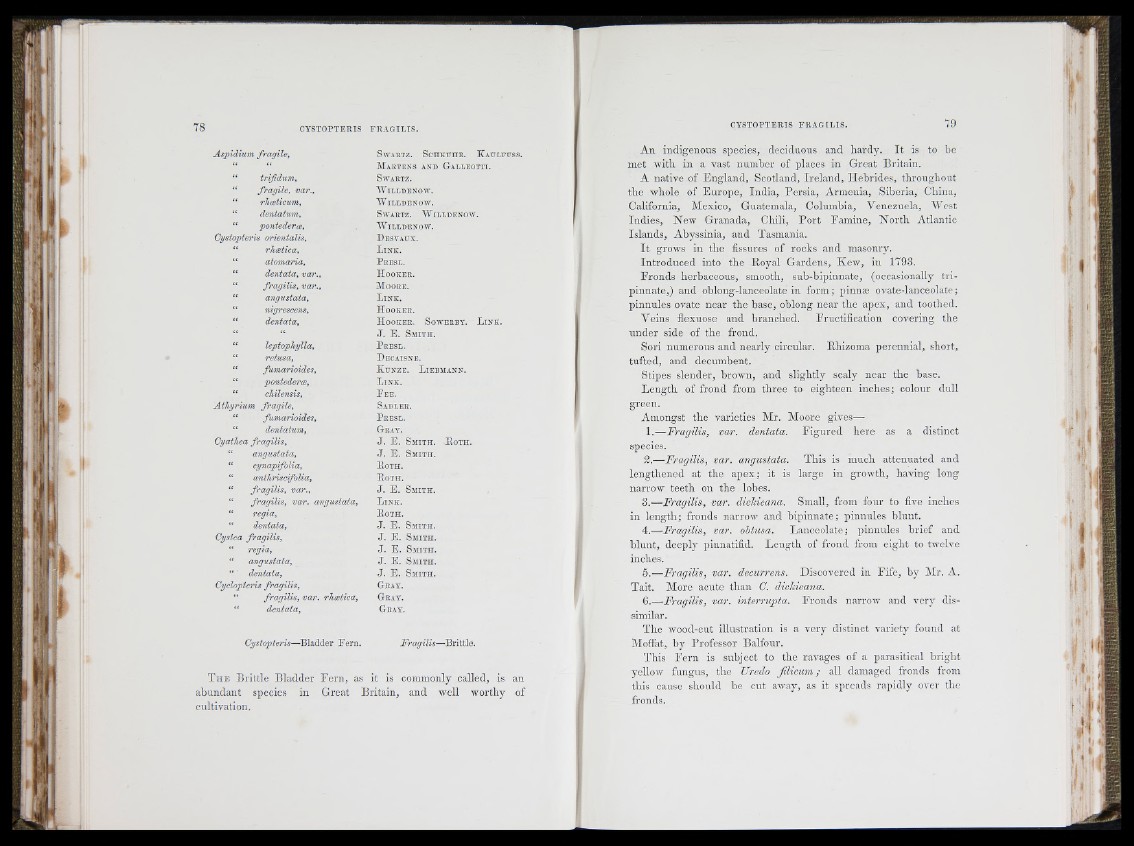
Asp id ium fra g ile ,
“ trifidum,
“ fra g ile , var.,
“ rlieeticum,
“ dentatum,
“ pontederm,
Cystopteris orienialis,
“ rlbcBtica,
“ atomaria,
“ dentata, var.
“ fr a g ilis , var.
“ angustata,
“ nigrescens,
“ dentata,
“ leptophylla,
“ retusa,
“ fumarioides,
A th y r ium fra g ile ,
“ fumarioides,
“ dentatum,
Cyathea fr a g ilis ,
“ angustata,
“ cynapifolia.
“ fr a g ilis , var.,
“ fr a g ilis , var. angustata,
“ regia,
“ dentata,
Cystea fra g ilis ,
“ regia,
“ angustata,
“ dentata,
Cyclopteris fra g ilis ,
fra g ilis , var. rhcetiea,
“ dentata.
Sw A E T Z . S cH K U H E . K a XTLFCSS.
M a e t e s s a n d G a l l e o t t i .
S n 'A E T Z .
"Willdenow.
"i'YlLLDEXOW.
Swartz. "IA^illdenow.
Willdenow.
Desvaux.
Link.
P besl.
H ooker.
J IO O EE .
Link.
Hookee.
H ookee. Soaverey. Link.
J . E. Smith.
P eesl.
Decatsne.
Kdnze. Liebmann.
.Link.
P ee.
Sadler.
P eesl.
Ge.at.
J . E. Smith. E oth,
J . E. Smith.
K o t h .
Koth.
J . E. Smith.
Link.
E o t h .
J. E . Smith,
J . E. Smith.
J . E. Saoth.
J . E. Smith.
J. E. Smith.
Geat.
Geat.
Gray.
Cystopteris—Eladder Fern. F ra g ilis—P r i t t l e .
T h e B rittle Bladder F e rn , as it is commonly called, is a n
abundant species in Great Britain, and well worthy of
cultivation.
A n indigenous species, deciduous and hardy. I t is to he
met Avith in a vast number of jilaces in Great Britain.
A native of F n g lan d , Scotland, Ire lan d , Hebrid e s, throughout
the whole of E uro p e , In d ia , Persia, Armenia, Siberia, China,
California, Mexico, Guatemala, Columbia, Venezuela, We st
Indies, NeAV Granada, Chili, P o rt Famine, N o rth Atlantic
Islands, Abyssinia, and Tasmania.
I t grows in the fissures of rocks and masonry.
In tro d u c ed into the Eoyal Gardens, K cav, in 1793.
F ronds herbaceous, smooth, sub-bipinnate, (occasionally tr ipinnate,)
and ohlong-lanceolate in form; ¡’Mnæ ovate-lanceolatc;
pinnules ovate near the base, ohlong near the apex, and toothed.
Veins flexuose and branched. Fructification covering the
un d e r side of the frond.
Sori numerous and nearly circular. Ehizoma perennial, short,
tufted, and decumbent.
Stipes slender, brown, and slightly scaly near the base.
L en g th of frond from three to eighteen inches; colour dull
g re en .
Amongst the varieties Mr. Moore gives—■
1.—Fragilis, m r . dentata. F ig u re d here as a distinct
species.
3.—Fragilis, var. angustata. This is much attenuated and
lengthened at the apex; it is large in groAvth, having long
narroAv teeth on the lobes.
3.—Fragilis, var. dicldeana. Small, from four to five inches
in length; fronds narrow and bipinnate; jiinnules blunt.
4 .—Fragilis, var. obtusa. Lanceolate; pinnules b rie f and
b lu n t, deeply pinnatifid. L en g th of frond from eight to twelve
inches.
5.—Fragilis, var. decurrens. Discovered in Fife, b y Mr. A.
Tait. More acute th an C. dickieana.
6 .—Fragilis, var. interrupta. Fronds narroAv and very dissimilar.
T he wood-cut illustration is a very distinct variety found at
Moffat, hy Professor Balfour.
T h i s F e r n i s s u b j e c t to t h e r a v a g e s o f a p a r a s i t i c a l b r i g h t
y e lloA v f u n g u s , t h e TJredo filic u m ; a l l d a m a g e d f r o n d s f r o m
t h i s c a u s e s h o u l d b e c u t aAvay, a s i t s p r e a d s r a p i d l y o v e r t h e
f r o n d s .
1 fj
I •, ll
I|
»,
» i
1 i
i
■ J